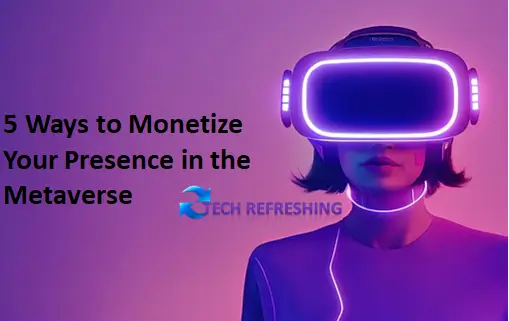The metaverse is a virtual world where users can interact and engage in various activities. As the metaverse continues to grow in popularity, many users are looking for ways to monetize their presence in this digital space. The metaverse presents a wide range of opportunities, from virtual real estate, virtual goods and services, virtual currency trading, virtual influencer marketing, and virtual event planning. In this blog post, we will explore in depth these five different ways to monetize your presence in the metaverse.
Virtual Real Estate
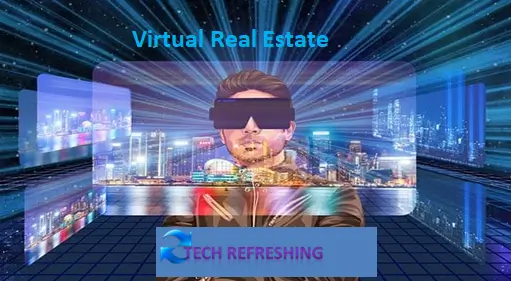
Virtual real estate is one of the most well-liked ways to monetise your presence in the metaverse. This may involve leasing out virtual space, purchasing and selling virtual land, and building virtual buildings or structures that other users may utilise.
By renting out virtual locations like offices, shops, or even apartments, you can make money from your presence in the metaverse by investing in virtual real estate. Or you can make money by building and selling other users virtual structures like homes, castles, or even entire towns. Decentraland, Somnium Space, Sandbox and Somnium are a few well-known virtual real estate platforms.
How it works
Virtual real estate is bought by purchasing a domain name, which serves as a website’s address. These domain names can be bought from registrars, who are approved by the Internet Corporation for Assigned Names and Numbers (ICANN), the organization responsible for managing the domain name system. Once a domain name is purchased, it can be used to create a website or virtual world. These digital properties can then be bought, sold, and traded on specialized marketplaces, similar to how physical real estate is bought and sold.
Types of Virtual Real Estate
There are several types of virtual real estate, each with their own unique characteristics and uses. Some examples include:
- Website domains: These are the addresses for websites and are typically the most common form of virtual real estate. They can be used to create a website for personal or business use, and can be bought and sold on the open market.
- Virtual worlds: These are digital environments that can be used for a variety of purposes, such as gaming, socializing, or education. They can be accessed through a computer or virtual reality device and often have their own virtual currency.
- Online marketplaces: These are digital platforms that allow users to buy and sell goods and services. Examples include e-commerce sites like Amazon and Etsy, and peer-to-peer marketplaces like eBay and Craigslist.
- Social media accounts: Some social media accounts can be considered virtual real estate if they have a large following or generate significant revenue. These accounts can be bought and sold on the open market.
Benefits and Risks
Virtual real estate offers advantages such as global reach, low expenses, and potential high returns but it also involves risks like fraud, hacking, lack of regulation and value fluctuation due to technology and market changes. , virtual real estate can be subject to rapid changes in technology and consumer preferences, which can also affect its value.
Virtual real estate is a growing market with a lot of potential, but it’s important to understand the risks and do proper research before investing.
Virtual Goods and Services
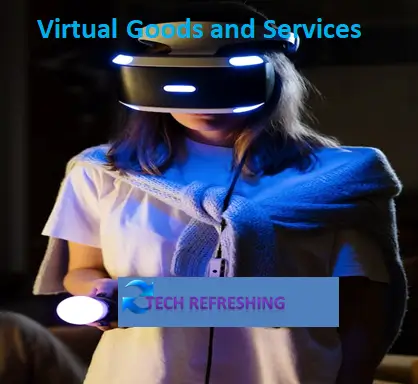
Another way to monetize your presence in the metaverse is by offering virtual goods and services to other users. Digital items that live in a virtual or online environment as opposed to the real world are referred to as virtual goods and services. These products can include anything from in-game items and virtual currency, to online courses and digital subscriptions. With the increasing popularity of online gaming and e-commerce, the market for virtual goods and services is rapidly growing. Some popular platforms for virtual goods and services include Decentraland, Somnium Space, and Somnium.
Types of Virtual Goods and Services:
There are several different types of virtual goods and services, each with their own unique characteristics and uses. Some of the common types were:
- In-game items: These are virtual items that can be used within a video game, such as weapons, armor, and cosmetic items. They are often used to enhance the gameplay experience or to personalize a player’s character.
- Virtual currency: This is a form of digital currency that can be used to purchase virtual goods and services within a virtual world or online game. Examples include coins, gold, and gems.
- Online courses and tutorials: These are digital products that provide educational content, such as video lectures and quizzes. They can be used for personal development or professional training.
- Digital subscriptions: These are recurring payments for access to digital content, such as online publications, music streaming services, and video streaming platforms.
Benefits of Virtual Goods and Services:
There are several benefits to using virtual goods and services, both for consumers and for businesses. Some of the notable benefits were:
- Convenience: Virtual goods and services can be purchased and accessed online, without the need to physically visit a store or location.
- Personalization: Virtual goods and services can be tailored to individual preferences and needs. For example, in-game items can be customized to match a player’s personal style.
- Cost-effectiveness: Virtual goods and services are often less expensive than their physical counterparts. Additionally, virtual goods can be easily replicated and distributed, reducing the costs associated with manufacturing and shipping.
- Scalability: Virtual goods and services can be easily scaled to meet demand, as there are no physical limitations on how many can be produced or sold.
Challenges and Risks:
While virtual goods and services offer many benefits, there are also challenges and risks associated with their use. Some of the significant challenges and risks were:
- Security: Virtual goods and services are stored and accessed online, which makes them vulnerable to hacking and other forms of cybercrime.
- Lack of regulation: Virtual goods and services are not always subject to the same regulations as physical goods, which can lead to issues such as fraud and scams.
- Lack of ownership: Virtual goods and services can be easily replicated and distributed, which can lead to issues of ownership and authenticity.
Virtual goods and services are an increasingly popular and important part of the digital economy. They offer many benefits, including convenience, personalization, and cost-effectiveness. There are also challenges and risks associated with their use, such as security and lack of regulation. Businesses and consumers must be aware of these dangers and obstacles as the market for virtual products and services expands and take precautions to reduce them.
Virtual Currency Trading
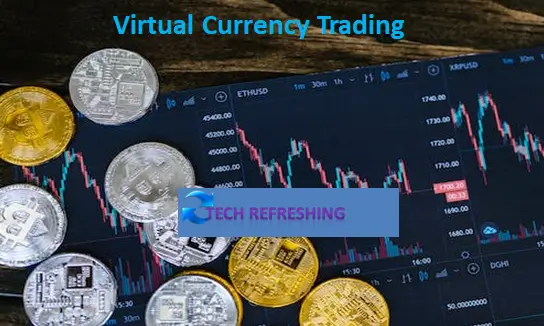
Another method of earning money in the metaverse is through trading virtual currencies, also called cryptocurrencies. These are digital forms of money that use encryption for security and can be transferred without the need for a central authority. Examples of cryptocurrencies include Bitcoin, Ethereum, Litecoin, and Ripple. Platforms for trading these currencies include Binance, Coinbase, and Bitfinex.
Virtual currency trading refers to the buying and selling of crypto currencies on online platforms. Virtual Currency trading referred to as cryptocurrency exchanges, allow individuals to trade virtual currencies for fiat currency (such as USD or EUR) or other virtual currencies.
How Virtual Currency Trading Works
Trading virtual currencies on an exchange typically involves the following steps:
- Setting up an account: To start trading virtual currencies, an individual must first create an account on a cryptocurrency exchange. This typically involves providing personal information and verifying one’s identity.
- Depositing funds: After setting up an account, an individual can deposit funds into their account. This can be done using a variety of methods, such as bank transfers or credit card payments.
- Buying and selling virtual currencies: Once funds have been deposited, an individual can then buy and sell virtual currencies on the exchange. The exchange will match buyers and sellers, and the exchange rate will be based on supply and demand.
- Withdrawing funds: When an individual wants to withdraw funds from their account, they can do so by transferring the funds back to their bank account or credit card.
Benefits of Virtual Currency Trading
- Decentralized: Virtual currencies are decentralized, meaning that they are not controlled by any government or financial institution. This can provide a level of security and privacy that is not possible with traditional currencies.
- Low transaction fees: Virtual currency transactions usually have very low transaction fees compared to traditional financial institutions.
- Borderless transactions: Virtual currencies can be sent and received anywhere in the world, making them useful for international transactions.
- 24/7 trading: Virtual currency exchanges are open 24/7, allowing individuals to trade at any time.
Risks of Virtual Currency Trading
- Volatility: Virtual currencies are highly volatile, meaning that their value can fluctuate greatly in a short period of time. This can lead to large losses for traders.
- Lack of regulation: Virtual currencies are not currently regulated by governments or financial institutions. This can make it difficult to protect against fraud and other financial crimes.
- Security risks: Virtual currency exchanges and wallets have been subject to hacking and other security breaches in the past. This can result in the loss of virtual currency.
- Risk of losing access to your virtual currency: Virtual currencies are stored in digital wallets, and if you lose access to your wallet, you will lose access to your virtual currency.
Virtual currency trading is the buying and selling of virtual currencies on online platforms called cryptocurrency exchanges. It offers a level of security and privacy that is not possible with traditional currencies and low transaction fees. However, it is highly volatile, not regulated, and has security risks. It is important to be fully informed before engaging in virtual currency trading.
Virtual Influencer Marketing

Another way to monetize your presence in the metaverse is through virtual influencer marketing. Virtual influencer marketing is a relatively new concept in the world of digital marketing, where companies and brands use computer-generated avatars or characters to promote their products or services. These virtual influencers are created using advanced technologies like 3D modeling, animation, and artificial intelligence, and can be used across various social media platforms, websites, and even in virtual reality environments.
What is Virtual Influencer Marketing?
Virtual influencer marketing is the practice of using computer-generated (CG) characters, or avatars, as brand ambassadors to promote products or services. These virtual influencers have the ability to interact with users in the metaverse, and they can also be used to create content on social media platforms. Virtual influencers can be used to target specific demographics, and they can be customized to appeal to different cultures and languages.
Benefits of Virtual Influencer Marketing in the Metaverse
- Increased engagement: Virtual influencers are able to interact with users in the metaverse in a way that traditional influencers cannot. This allows for increased engagement and a more personalized experience for the user.
- Cost-effective: Virtual influencers do not require the same expenses as human influencers, such as travel and accommodation costs. This makes virtual influencer marketing a cost-effective option for brands.
- Increased scalability: Virtual influencers can be used to target specific demographics and can be customized to appeal to different cultures and languages. This allows for increased scalability and the ability to reach a wider audience.
- 24/7 availability: Virtual influencers can be available 24/7, allowing brands to reach consumers at any time.
- Authenticity: Virtual influencers can be designed to be as authentic and relatable as human influencers. They can be programmed to have a specific personality, backstory, and interests, which can make them more relatable to consumers.
Challenges of Virtual Influencer Marketing in the Metaverse
- Lack of trust: Virtual influencers are not human, and some consumers may not trust or be comfortable interacting with them.
- Technical limitations: The technology used to create virtual influencers is still in its early stages, and there may be limitations to what they can do.
- Ethical concerns: The use of virtual influencers raises ethical concerns, such as the blurring of the line between reality and fiction and the potential exploitation of consumers.
Virtual influencer marketing in the metaverse presents a new opportunity for brands to reach and engage with consumers in a unique and immersive way. It also comes with its own set of challenges, such as a lack of trust and ethical concerns. As technology continues to progress and the metaverse continues to grow, it will be important for brands to navigate these challenges and find ways to use virtual influencers in an authentic and transparent way.
Virtual Event Planning
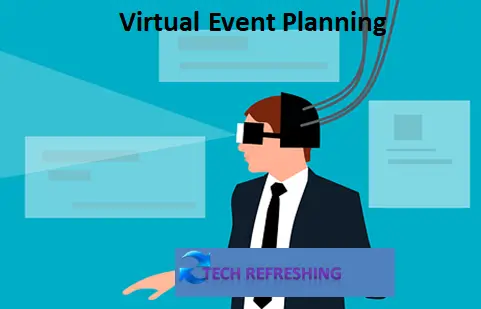
A fifth way to monetize your presence in the metaverse is through virtual event planning. With the rise of virtual reality and other technologies, the metaverse is becoming an increasingly popular platform for hosting virtual events. Virtual events, such as conferences, trade shows, and concerts, can be held in the metaverse, allowing attendees to participate from anywhere in the world. . Some popular platforms for virtual event planning include Decentraland, Somnium Space, and Somnium. Let’s see the key considerations for planning and hosting a virtual event in the metaverse.
Choosing a Platform
The first step in planning a virtual event in the metaverse is to choose a platform. There are several different options available, including Second Life, Sansar, and VRChat. Each platform has its own set of features and limitations, so it’s important to research the different options and select the one that best suits your event’s needs.
Designing the Event Space
Once you have selected a platform, you’ll need to design the event space. This includes creating the layout, selecting the color scheme, and adding lighting, sound, and other effects. It’s important to keep in mind that the event space should be easy to navigate and should be designed to create a sense of immersion for the attendees.
Creating Event Content
The next step is to create the event content. This includes creating the schedule of events, creating the keynote speakers, and creating the virtual exhibitor booths. The key to creating effective event content is to make sure that it is engaging and interactive. This can be achieved by using interactive features such as polls, quizzes, and live chat.
Promoting the Event
Once the event is designed and the content is created, it’s time to promote the event. This includes creating a website, creating social media pages, and sending out email invitations. It’s important to start promoting the event as early as possible to give attendees enough time to plan and register.
Hosting the Event
Finally, it’s time to host the event. This includes setting up the event space, welcoming attendees, and hosting the different events and activities. It’s important to have a dedicated team in place to handle any technical issues that may arise during the event.
Hosting a virtual event in the metaverse is a great way to reach a global audience and create an immersive experience for attendees. By following the steps outlined in this article, you can ensure that your virtual event is a success.
It is important to keep in mind that virtual events are different from in-person events and require different approaches for design, content and technical aspects. With the right approach, virtual events can be a great way to connect with audiences and provide an engaging and immersive experience.
Conclusion:
This is important to remember that, like with any emerging technology, the metaverse is still developing and it’s uncertain which opportunities will prove to be the most viable in the long run. It’s crucial to take into account the legal and regulatory aspects related to earning revenue from virtual assets. Thus, it’s advisable to conduct thorough research and seek expert advice before making any decisions.
Overall, the metaverse offers a wide range of monetization opportunities for those who are willing to be creative and adapt to new trends. Whether you’re interested in virtual real estate, virtual goods and services, virtual currency trading, virtual influencer marketing, or virtual event planning, there are many ways to monetize your presence in the metaverse and earn a sustainable income.

